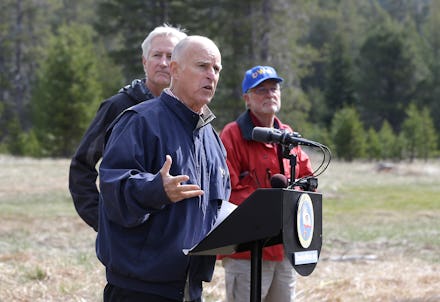California's Biblical Drought Is Forcing Gov. Brown to Set Unprecedented Water Limits

California Gov. Jerry Brown announced Wednesday that the state would be imposing mandatory water restrictions for the first time in its history. The unprecedented move came in response to a drought of biblical proportions that has now plagued the state for years.
Speaking on a mountain near Lake Tahoe, Brown told gathered reporters, "Today we are standing on dry grass where there should be five feet of snow," according to the Washington Post, which also reported that the area averages 66 inches of snow at this time of year. It presently has none.
In an executive order, Brown vowed that the restrictions would help reduce water consumption in the state by 25%, which over the next nine months would save roughly 1.5 million acre-feet of water, which translated to about 4.88777143 × 10^11 U.S. gallons — in other words, a whole lot.
"They rely on snow for about a third of the water supply," Stephanie Locke, the Water Demand Manager at the Monterey Peninsula Water Management District, told Mic. "They'll be relying more on groundwater, and existing stores of reservoirs." Locke added that that this was no solution as since "most reservoirs in state are at critically low levels."
In March, a senior water scientist for NASA estimated that the state only had one year left of water.
The bigger picture. While it is impossible to definitively link the drought to climate change, there are two things not in dispute: The planet is getting warmer and rising temperatures make droughts worse. The hotter it gets, the drier the soil becomes and the more water is lost into the atmosphere through evaporation.
California water loss could take a catastrophic toll on the state's agriculture. According to their Agricultural Statistics Review, the state grows 99% of American olives, peaches, artichokes, dates and pomegranates. It also leads the nation in dozens of other fruits and vegetables. Without California, Americans might not have these items, but without water, California would not be able to continue growing them.
The problem is not merely a California one, either. An arguably greater crisis underway is the depletion of the Ogallala Aquifer, a critical source of water for farming across much of the Midwest that also supplies 30% of America's irrigated groundwater. A 2013 study found the aquifer was being depleted significantly faster than rainwater could restore it and that it would take "500-1,300 [years] to completely refill a depleted aquifer."
On top of that, nationally, a National Resources Defense Council report found "1,100 counties — one-third of all counties in the lower 48 states — face higher risks of water shortages by mid-century as the result of climate change. More than 400 of these counties will face extremely high risks of water shortages."
To be clear, it's not Interstellar-level drought just yet. Changes to farming practices in the Midwest could push off the issues with Ogallala by decades and then mitigate its effects thereafter. While in California, Locke said technological innovations like desalinization of seawater and using water more efficiently would be necessary and a good first step.
"Everybody has to do their part to reduce water use," Locke said. She's right. Whether it's reducing climate change at the macro level or changing our own behavior at the micro, at the end of the day, it comes down to us.